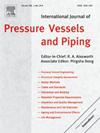基于声发射信号的供水管网泄漏检测的优化vmd -小波去噪方法
IF 3
2区 工程技术
Q2 ENGINEERING, MECHANICAL
International Journal of Pressure Vessels and Piping
Pub Date : 2025-05-10
DOI:10.1016/j.ijpvp.2025.105535
引用次数: 0
摘要
供水管网的泄漏检测对基础设施的维护至关重要,而传统的方法依赖于监听设备,效率低,耗时长。声发射(AE)技术由于其非破坏性和对环境影响最小的特性而成为一种很有前途的替代技术。然而,环境噪声严重影响了其有效性,降低了信噪比(SNR),使泄漏检测变得复杂。为了解决这一挑战,我们提出了一种优化的基于ae的泄漏检测的vmd -小波去噪方法。我们的方法引入了三个关键创新:使用北鹰优化(NGO)算法自适应VMD参数优化,确保最优模式分解;基于相关性的IMF选择,有效滤除无关成分,增强信号清晰度;改进的小波阈值去噪,细化高频成分,最大限度地抑制噪声,同时保留泄漏相关特征。在模拟和真实数据集上进行的大量实验表明,我们提出的方法优于传统方法,将信噪比从20.27提高到30.58(约提高50%),并实现了94.63%的高平均泄漏检测精度。我们的工作促进了管道监测技术的发展,为维护现实世界的供水网络提供了更有效的解决方案。本文章由计算机程序翻译,如有差异,请以英文原文为准。
An optimized VMD-wavelet denoising method for leakage detection in water supply networks from acoustic emission signals
Leakage detection in water supply networks is critical for infrastructure maintenance, while traditional methods relying on listening devices are inefficient and time-consuming. Acoustic emission (AE) technology has emerged as a promising alternative due to its non-destructive nature and minimal environmental impact. However, its effectiveness is significantly hindered by environmental noise, which degrades the signal-to-noise ratio (SNR) and complicates leakage detection. To address this challenge, we propose an optimized VMD-wavelet denoising method tailored for AE-based leakage detection. Our approach introduces three key innovations: Adaptive VMD parameter optimization using the Northern Goshawk Optimization (NGO) algorithm, ensuring optimal mode decomposition; Correlation-based IMF selection, effectively filtering out irrelevant components to enhance signal clarity; and Improved wavelet threshold denoising, which refines high-frequency components to maximize noise suppression while preserving leakage-related features. Extensive experiments on simulated and real-world datasets demonstrate that our proposed method outperforms conventional approaches, increasing the SNR from 20.27 to 30.58 (approximately a 50% increase) and achieving a high average leakage detection accuracy of 94.63%. Our work contributes to the advancement of pipeline monitoring technologies, providing a more effective solution for maintaining real-world water supply networks.
求助全文
通过发布文献求助,成功后即可免费获取论文全文。
去求助
来源期刊
CiteScore
5.30
自引率
13.30%
发文量
208
审稿时长
17 months
期刊介绍:
Pressure vessel engineering technology is of importance in many branches of industry. This journal publishes the latest research results and related information on all its associated aspects, with particular emphasis on the structural integrity assessment, maintenance and life extension of pressurised process engineering plants.
The anticipated coverage of the International Journal of Pressure Vessels and Piping ranges from simple mass-produced pressure vessels to large custom-built vessels and tanks. Pressure vessels technology is a developing field, and contributions on the following topics will therefore be welcome:
• Pressure vessel engineering
• Structural integrity assessment
• Design methods
• Codes and standards
• Fabrication and welding
• Materials properties requirements
• Inspection and quality management
• Maintenance and life extension
• Ageing and environmental effects
• Life management
Of particular importance are papers covering aspects of significant practical application which could lead to major improvements in economy, reliability and useful life. While most accepted papers represent the results of original applied research, critical reviews of topical interest by world-leading experts will also appear from time to time.
International Journal of Pressure Vessels and Piping is indispensable reading for engineering professionals involved in the energy, petrochemicals, process plant, transport, aerospace and related industries; for manufacturers of pressure vessels and ancillary equipment; and for academics pursuing research in these areas.

 求助内容:
求助内容: 应助结果提醒方式:
应助结果提醒方式:


